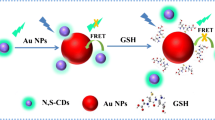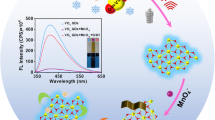Abstract
In the work, a fluorescence switch sensor consists of Mn-doped CdTe quantum dots (QDs) - methyl viologen (MV2+) nanohybrid is fabricated. In the sensor, MV2+ plays a role in turning the QDs fluorescence to the “OFF” state due to the efficient electron transfer process while glutathione (GSH) could turn “ON” the native QDs fluorescence by effectively releasing QDs from the QDs-MV2+ nanohybrids. In addition, the recovery level of QDs fluorescence is closely related to the amount of GSH. Based on this phenomenon, a reliable and convenient GSH quantitative determination method is established, which not only has a wide determination range of 1.2–200 μM, a low detection limit of 0.06 μM and a short detection time but also can realize the selective detection of GSH upon other competitive biothiols (homocysteine and cysteine) that are coexistent in biological systems. The developed sensor will greatly benefit to the study of GSH amount, helping the understanding of its function in biological systems.












Similar content being viewed by others
References
Atli G, Canli M (2008) Responses of metallothionein and reduced glutathione in a freshwater fish Oreochromis niloticus following metal exposures. Environ Toxicol Pharmacol 25:33–38. doi:10.1016/j.etap.2007.08.007
Yin J, Kwon Y, Kim D, Lee D, Kim G, Hu Y, Ryu JH, Yoon J (2014) Cyanine-based fluorescent probe for highly selective detection of glutathione in cell cultures and live mouse tissues. J Am Chem Soc 136:5351–5358. doi:10.1021/Ja412628z
Yuan Y, Zhang J, Wang MJ, Mei B, Guan YF, Liang GL (2013) Detection of glutathione in vitro and in cells by the controlled self-assembly of nanorings. Anal Chem 85:1280–1284. doi:10.1021/Ac303183v
Krauth-Siegel RL, Bauer H, Schirmer H (2005) Dithiol proteins as guardians of the intracellular redox milieu in parasites: old and new drug targets in trypanosomes and malaria-causing plasmodia. Angew Chem Int Ed 44:690–715. doi:10.1002/anie.200300639
Lu SC (2009) Regulation of glutathione synthesis. Mol Aspects Med 30:42–59. doi:10.1016/j.mam.2008.05.005
Hodakova J, Preisler J, Foret F, Kuban P (2015) Sensitive determination of glutathione in biological samples by capillary electrophoresis with green (515 nm) laser-induced fluorescence detection. J Chromatogr A 1391:102–108. doi:10.1016/j.chroma.2015.02.062
Shen CC, Tseng WL, Hsieh MM (2012) Selective extraction of thiol-containing peptides in seawater using Tween 20-capped gold nanoparticles followed by capillary electrophoresis with laser-induced fluorescence. J Chromatogr A 1220:162–168. doi:10.1016/j.chroma.2011.11.057
Kominkova M, Horky P, Cernei N, Tmejova K, Ruttkay-Nedecky B, Guran R, Pohanka M, Zitka O, Adam V, Kizek R (2015) Optimization of the glutathione detection by high performance liquid chromatography with electrochemical detection in the brain and liver of rats fed with taurine. Int J Electrochem Sci 10:1716–1727
Bayram B, Runbach G, Frank J, Esatbeyoglu T (2014) Rapid method for glutathione quantitation using high-performance liquid chromatography with coulometric electrochemical detection. J Agric Food Chem 62:402–408. doi:10.1021/Jf403857h
Rezaei B, Khosropour H, Ensafi AA, Hadadzadeh H, Farrokhpour H (2015) A differential pulse voltammetric sensor for determination of glutathione in real samples using a Trichloro(terpyridine) ruthenium (III)/Multiwall carbon nanotubes modified paste electrode. IEEE Sens J 15:483–490. doi:10.1109/Jsen.2014.2343152
Yuan BQ, Zhang RC, Jiao XX, Li J, Shi HZ, Zhang DJ (2014) Amperometric determination of reduced glutathione with a new Co-based metal-organic coordination polymer modified electrode. Electrochem Commun 40:92–95. doi:10.1016/j.elecom.2014.01.006
Ni PJ, Sun YJ, Dai HC, Hu JT, Jiang S, Wang YL, Li Z (2015) Highly sensitive and selective colorimetric detection of glutathione based on Ag [I] ion-3,3 ′,5,5 ′-tetramethylbenzidine (TMB). Biosens Bioelectron 63:47–52. doi:10.1016/j.bios.2014.07.021
Chen ZG, Wang Z, Chen JH, Wang SB, Huang XP (2012) Sensitive and selective detection of glutathione based on resonance light scattering using sensitive gold nanoparticles as colorimetric probes. Analyst 137:3132–3137. doi:10.1039/C2an35405e
Hu ZQ, Sun LL, Gu YY, Jiang Y (2015) A sensitive and selective fluorescent probe for detection of glutathione in the presence of Cu2+ and its application to biological imaging. Sensors Actuators B Chem 212:220–224. doi:10.1016/j.snb.2015.01.084
Hou XF, Guo XL, Chen B, Liu CH, Gao F, Zhao J, Wang JH (2015) Rhodamine-based fluorescent probe for highly selective detection of glutathione over cysteine and homocysteine. Sensors Actuators B Chem 209:838–845. doi:10.1016/j.snb.2014.12.009
Park KS, Kim MI, Woo MA, Park HG (2013) A label-free method for detecting biological thiols based on blocking of Hg2+−quenching of fluorescent gold nanoclusters. Biosens Bioelectron 45:65–69. doi:10.1016/j.bios.2013.01.047
Zhang N, Qu F, Luo HQ, Li NB (2013) Sensitive and selective detection of biothiols based on target-induced agglomeration of silver nanoclusters. Biosens Bioelectron 42:214–218. doi:10.1016/j.bios.2012.10.090
Guan ZP, Li S, Cheng PBS, Zhou N, Gao NY, Xu QH (2012) Band-selective coupling-induced enhancement of two-photon photoluminescence in gold nanocubes and its application as turn-on fluorescent probes for cysteine and glutathione. ACS Appl Mater Interfaces 4:5711–5716. doi:10.1021/Am301822v
Liu XD, Sun R, Ge JF, Xu YJ, Xu Y, Lu JM (2013) A squaraine-based red emission off-on chemosensor for biothiols and its application in living cells imaging. Org Biomol Chem 11:4258–4264. doi:10.1039/C3ob40502h
Guo YS, Wang H, Sun YS, Qu B (2012) A disulfide bound-molecular beacon as a fluorescent probe for the detection of reduced glutathione and its application in cells. Chem Commun 48:3221–3223. doi:10.1039/C2cc17552e
Isik M, Ozdemir T, Turan IS, Kolemen S, Akkaya EU (2013) Chromogenic and fluorogenic sensing of biological thiols in aqueous solutions using BODIPY-based reagents. Org Lett 15:216–219. doi:10.1021/Ol303306s
Xu Q, Wei HP, Hu XY (2013) Glutathione detection based on ZnS quantum-dot-based OFF-ON fluorescent probe. Chin J Anal Chem 41:1102–1106. doi:10.3724/Sp.J.1096.2013.21154
Liu JF, Bao CY, Zhong XH, Zhao CC, Zhu LY (2010) Highly selective detection of glutathione using a quantum-dot-based OFF-ON fluorescent probe. Chem Commun 46:2971–2973. doi:10.1039/B924299f
Deng RR, Xie XJ, Vendrell M, Chang YT, Liu XG (2011) Intracellular glutathione detection using MnO2-Nanosheet-Modified upconversion nanoparticles. J Am Chem Soc 133:20168–20171. doi:10.1021/Ja2100774
Zhou L, Lin YH, Huang ZZ, Ren JS, Qu XG (2012) Carbon nanodots as fluorescence probes for rapid, sensitive, and label-free detection of Hg2+ and biothiols in complex matrices. Chem Commun 48:1147–1149. doi:10.1039/C2cc16791c
Ran X, Sun HJ, Pu F, Ren JS, Qu XG (2013) Ag Nanoparticle-decorated graphene quantum dots for label-free, rapid and sensitive detection of Ag+ and biothiols. Chem Commun 49:1079–1081. doi:10.1039/C2cc38403e
Huang H, Shi FP, Li YA, Niu L, Gao Y, Shah SM, Su XG (2013) Water-soluble conjugated polymer-Cu(II) system as a turn-on fluorescence probe for label-free detection of glutathione and cysteine in biological fluids. Sensors Actuators B Chem 178:532–540. doi:10.1016/j.snb.2013.01.003
Pradhan N, Peng XG (2007) Efficient and color-tunable Mn-doped ZnSe nanocrystal emitters: control of optical performance via greener synthetic chemistry. J Am Chem Soc 129:3339–3347. doi:10.1021/Ja068360v
Sharma M, Jain T, Singh S, Pandey OP (2012) Tunable emission in surface passivated Mn-ZnS nanophosphors and its application for Glucose sensing. Aip Adv 2. doi: 10.1063/1.3698310
Bian W, Ma J, Liu QL, Wei YL, Li YF, Dong C, Shuang SM (2014) A novel phosphorescence sensor for Co2+ ion based on Mn-doped ZnS quantum dots. Luminescence 29:151–157. doi:10.1002/Bio.2520
Zhou M, Chen XF, Xu YY, Qu JC, Jiao LX, Zhang HG, Chen HL, Chen XG (2013) Sensitive determination of Sudan dyes in foodstuffs by Mn-ZnS quantum dots. Dyes Pigments 99:120–126. doi:10.1016/j.dyepig.2013.04.027
Liang GX, Pan HC, Li Y, Jiang LP, Zhang JR, Zhu JJ (2009) Near infrared sensing based on fluorescence resonance energy transfer between Mn:CdTe quantum dots and Au nanorods. Biosens Bioelectron 24:3693–3697. doi:10.1016/j.bios.2009.05.008
Li L, Cai XY, Ding YP, Gu SQ, Zhang QL (2013) Synthesis of Mn-doped CdTe quantum dots and their application as a fluorescence probe for ascorbic acid determination. Anal Methods 5:6748–6754. doi:10.1039/C3ay41257a
DiazCruz MS, Mendieta J, Tauler R, Esteban M (1997) Cadmium-binding properties of glutathione: a chemometrical analysis of voltammetric data. J Inorg Biochem 66:29–36. doi:10.1016/S0162-0134(96)00156-0
Zhang YH, Zhang HS, Ma M, Guo XF, Wang H (2009) The influence of ligands on the preparation and optical properties of water-soluble CdTe quantum dots. Appl Surf Sci 255:4747–4753. doi:10.1016/j.apsusc.2008.09.009
Zhang LJ, Xu CL, Li BX (2009) Simple and sensitive detection method for chromium(VI) in water using glutathione-capped CdTe quantum dots as fluorescent probes. Microchim Acta 166:61–68. doi:10.1007/s00604-009-0164-0
Han BY, Yuan JP, Wang EK (2009) Sensitive and selective sensor for biothiols in the cell based on the recovered fluorescence of the CdTe quantum dots-Hg(II) system. Anal Chem 81:5569–5573. doi:10.1021/Ac900769h
Xu H, Wang YW, Huang XM, Li Y, Zhang H, Zhong XH (2012) Hg2+−mediated aggregation of gold nanoparticles for colorimetric screening of biothiols. Analyst 137:924–931. doi:10.1039/C2an15926k
Li Y, Wu P, Xu H, Zhang H, Zhong XH (2011) Anti-aggregation of gold nanoparticle-based colorimetric sensor for glutathione with excellent selectivity and sensitivity. Analyst 136:196–200. doi:10.1039/C0an00452a
Liu X, Wang Q, Zhang Y, Zhang LC, Su YY, Lv Y (2013) Colorimetric detection of glutathione in human blood serum based on the reduction of oxidized TMB. New J Chem 37:2174–2178. doi:10.1039/C3nj40897c
Ma YH, Zhang ZY, Ren CL, Liu GY, Chen XG (2012) A novel colorimetric determination of reduced glutathione in A549 cells based on Fe3O4 magnetic nanoparticles as peroxidase mimetics. Analyst 137:485–489. doi:10.1039/C1an15718c
Shi YP, Pan Y, Zhang H, Zhang ZM, Li MJ, Yi CQ, Yang MS (2014) A dual-mode nanosensor based on carbon quantum dots and gold nanoparticles for discriminative detection of glutathione in human plasma. Biosens Bioelectron 56:39–45. doi:10.1016/j.bios.2013.12.038
Banerjee S, Kar S, Perez JM, Santra S (2009) Quantum dot-based OFF/ON probe for detection of glutathione. J Phys Chem C 113:9659–9663. doi:10.1021/Jp9019574
Tang YR, Song HJ, Su YY, Lv Y (2013) Turn-on persistent luminescence probe based on graphitic carbon nitride for imaging detection of biothiols in biological fluids. Anal Chem 85:11876–11884. doi:10.1021/Ac403517u
Matylitsky VV, Dworak L, Breus VV, Basche T, Wachtveitl J (2009) Ultrafast charge separation in multiexcited CdSe quantum dots mediated by adsorbed electron acceptors. J Am Chem Soc 131:2424. doi:10.1021/Ja808084y
Acknowledgments
This research is supported by the National Natural Science Foundation of China (NSFC) (No. 21271127, 61171033), the Nano-Foundation of Science and Techniques Commission of Shanghai Municipality (No. 12nm0504200) and the Natural Science Foundation of Shanghai Municipality (No. 13ZR1415600).
Author information
Authors and Affiliations
Corresponding author
Rights and permissions
About this article
Cite this article
Yu, L., Li, L., Ding, Y. et al. A Fluorescent Switch Sensor for Glutathione Detection Based on Mn-doped CdTe Quantum Dots - Methyl Viologen Nanohybrids. J Fluoresc 26, 651–660 (2016). https://doi.org/10.1007/s10895-015-1751-6
Received:
Accepted:
Published:
Issue Date:
DOI: https://doi.org/10.1007/s10895-015-1751-6




